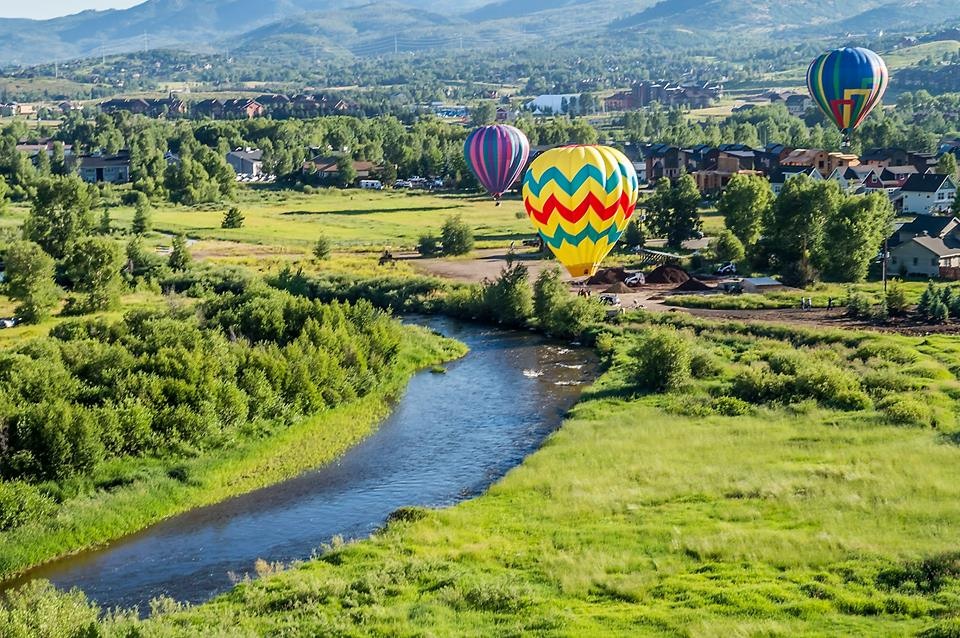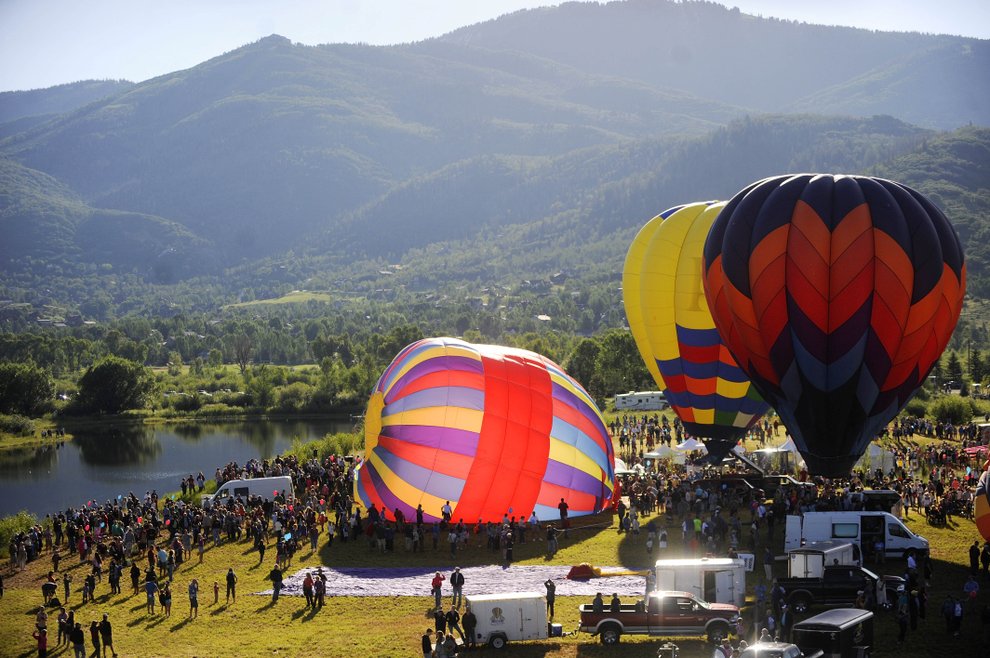
The “Stratosaurus” hot air balloon looked like an inverted and mismatched candy corn: an orange cone, white middle and red base. However, Stratosaurus’ orange, white and red nylon panels were sewn to form a teardrop shape that, once fully inflated, was big enough to fit more than 549 million candy corns, or at least 20 school buses.
Stratosaurus belonged to Chauncey Dunn, a Denver-based real estate agent with a hot air ballooning obsession. In 1969, he’d bought his first balloon, and due to recreational ballooning’s rarity at the time, he’d taught himself with minimal instruction how to pilot and operate it.
In 1971, Dunn brought Stratosaurus outside Longmont, attached a wicker basket and filled the balloon with hot air. They rose over the Front Range, climbing alongside the mountains, scanning the sprawling miles of the great plains. On that flight, he maneuvered Stratosaurus upwards more than 33,400 feet, breaking all previous hot air balloon altitude records and approaching the cruising altitude of most commercial airplanes.
Dunn and Stratosaurus far surpassed the expectations of French brothers Joseph and Jacques Montgolfier, whose pioneer hot air balloon prototype sent a duck, rooster and sheep aloft in 1783. The Montgolfier brothers’ first balloon was constructed from a mix of paper and fabric and fueled by hot air generated from a straw fire. Today, in response to many fire accidents and rough starts, balloons are typically sewn with nylon and fueled by gas.
Within a year of his record-setting flight, Dunn fueled his ballooning obsession by founding his own commercial ballooning company, and over the next five years he also helped found the Colorado Balloon Club and the Rocky Mountain Gas Balloon Society. As he pushed ballooning’s vertical limits, he also pressed horizontal public outreach across the state.
Dunn passed away in 2012, but in 2014 he was inducted into the ballooning hall of fame by The National Balloon Museum, which said, “More than any other person, Chauncey was responsible for bringing the sport of ballooning to Colorado.”
Now, nearly a half century after Dunn purchased his first balloon, with numerous hot air balloon companies based in Boulder and dozens scattered across the state, Colorado has swelled into an internationally recognized ballooning destination. Just ask Scott Appelman, a seasoned balloonist and producer for Colorado Springs’ “Labor Day Lift Off,” the largest hot air balloon festival in Colorado and noted by CNN as one of the top 10 balloon festivals in the world.
“The popularity is growing… I was blown away by the amount of people attending [Labor Day Lift Off last year: more than 150,000],” Appelman says.
He credits three factors for Colorado’s ballooning popularity above other U.S. locations: the weather, the landscape and the culture. Several weather systems sprinkled around Colorado, particularly in areas like Colorado Springs and Steamboat Springs, make for optimal conditions with calm, clear mornings. In Colorado Springs, as the balloons take off under Pikes Peak’s shadow, he says, “it’s green; it’s beautiful flying.”

Modern hot air balloons have three main parts: the big balloon, referred to as the envelope, the basket, called a gondola, and the gas burner that provides heat. Most balloons are teardrop-shaped and employ nylon because of its lightweight and high-melting temperature. The base of the balloon is also coated with special fire-resistant material to ensure the flame doesn’t damage the balloon. The gondola, holding the passengers, hangs below the balloon and the gas burner sits right at the balloon’s mouth.
They fly because of a basic scientific principle: Hot air is less dense than cold air, which means that hot air will rise and cooler air will stay or sink once they come in contact. A cubic foot of air weighs about 28 grams, but if you heat it up by 100 degrees Fahrenheit, it’ll weigh about 7 grams less. This means that each cubic foot of hot air can lift 7 grams of weight. This isn’t a lot, which is why hot air balloons are so big. To lift 1,000 pounds, you would need about 65,000 cubic feet of hot air, or more than the volume of 70 school buses.
To heat the air, modern balloons use propane, the same as a barbeque uses. Stored in a compressed liquid form, the gas runs through hot coils and provides a fierce, efficient flame positioned right below the balloon. As the flame burns, the air around it heats up, sending the lighter air molecules directly to the top of the balloon, resulting in the buoyant lifting effect.
Vertical speed is controlled by the size of the flame: The bigger the flame, the faster the air heats and rises. Navigating the vertical space is relatively easy. When balloonists want to come down, there’s a small slit called a parachute valve that rings around the top of the balloon. The pilot can gently open it, letting some hot air escape and lowering the balloon’s buoyant force. Moving horizontally is slightly more complicated because there is no rudder or steering mechanism — the balloon moves left and right, forwards and backwards at the whim of the winds. Because wind blows in different directions at different altitudes, however, savvy pilots can adjust their vertical levels to float in air currents of their choosing, making hot air ballooning a largely improvised sport, rarely landing in precise locations.
“You have friendly people,” Appelman says. “You may end up in someone’s backyard, but the people are so welcoming and the culture makes it so enjoyable.”
“Sometimes we take for granted what’s in our backyard, but it’s something that I don’t lose sight of when I’m flying [in Colorado],” Appelman says.
Theoretically, a hot air balloon would keep lifting as long as the flame heats the air, or until the upper atmospheric air becomes too thin, not only too weak to lift the balloon, but also too sparse to supply a human passenger’s vital oxygen needs. In 1979, with a larger balloon named Bear Cat, Dunn broke the ballooning altitude record again. This time, he wore a special suit, astronaut boots and gloves to help stave off the harsh atmospheric environment. Having reached 53,200 feet, he was officially, for a brief moment, the highest human in history, and then he was promptly hospitalized for a mild case of oxygen narcosis.
Although his record is no longer the highest in the world (Vijaypat Singhania of India flew to 69,850 feet), it still remains the highest altitude mark in North America. Despite his passing, Dunn leaves behind quite a ballooning legacy which includes numerous traditions, festivals and companies.

Balloonists flock to Colorado to lift off from some of the highest altitude launch sites in the country, allowing them to soar to heights seldom so easily attained elsewhere. Hot air balloon festivals and rodeos, which occur throughout Colorado during late summer, feature dozens of brightly decorated balloons, a host of family-friendly activities, food vendors and sometimes live music. Debby Standefer, owner and operator of the Rocky Mountain Balloon Festival and balloon meister of the Steamboat Springs Hot Air Balloon Rodeo, knows “people come from all over to see the balloons fly.” She estimates there are about 110 licensed hot air balloon pilots in Colorado.
“Here’s the scoop,” she says. “They’re just magic.”
Kids, adults and the elderly alike can enjoy themselves under the shadows of great big balloons, Standefer says. “Typically, in Steamboat Springs Valley the winds are calm, so it’s very cool for people to watch the balloons just hang out and not fly away.”
“I’ve flown all across the country, and the attraction to Colorado is the scenery,” she says. “It’s breathtakingly beautiful. It just makes your heart hurt.”














